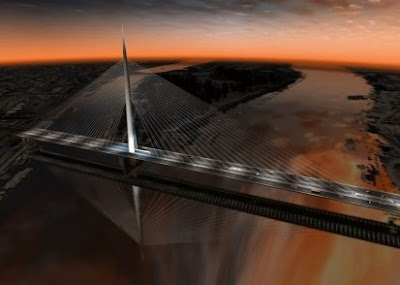by Snezana Ilic
In everything that man pushes by his vital instinct, builds and raises, nothing is more beautiful or more precious than bridges. Bridges are more important than houses, more sacred because they are more useful than temples. They belong to everybody and they are the same for everybody, always built in the right place in which the major part of human necessity crosses, more durable than all other constructions and they do not serve for anything secret or bad.
Using those words the Yugoslavian writer who was awarded the Nobel Prize for Literature, Ivo Andric, explained his ardor for bridges almost 50 years ago.
 |
| The Sava Bridge, Belgrade, Serbia |
A few months ago, when I saw the newly built bridge on the Sava River in Belgrade, Serbia - I felt the same enthusiasm. The bridge is standing proudly and waiting to be officially opened for traffic in December 2011, aiming to become the new symbol of the city.
The necessity of the bridge is clear having in mind that the city is situated on the constellation of two rivers, the Danube and the Sava, and has 1.7 million residents with only two functioning bridges across the rivers to connect the old part of the town (The Old Belgrade) and the new one which stands for business center (The New Belgrade). Furthermore, the bridge represents the missing element of the The Inner Major Half-Ring (UMP) that connects Western and Northern part and much larger area of the city.
However, the opponents of this construction were very loud in the years before the building started. Many architects stated that this bridge would present physical danger, and it would be unsuitable to build a main road through the city core which would give to the residents of Belgrade an enormously expensive and dysfunctional bridge in the wrong place.
According to the results of previous studies on the bridge , estimated positive effects are numerous. First, the results of the analysis which used the volume of traffic in 2005. showed that there would be decrease in mileage by about 100,000 km per day if only passenger cars are taken into consideration. This would save about 11 tons of fuel a day. There would be used 3,250 tons less fuel per year. By 2021 year, when the volume of traffic is expected to increase by 35%, results are even more significant amounting to savings of about 35 tons of fuel per day or 10,000 tons per year. As a consequence of those savings, there will be less air pollution. Second, the average time required for travel would be shorter by around 30 minutes. Third, the new bridge and the ring would reduce traffic flows on existing roads and bridges in the center (30%), and thus eliminate delays and adverse effects caused by this (the project itself provides a series of effective measures of environmental protection, specific pavement, protective sound barrier, etc.). This list can be extended with less tangible benefits such as the bridge would provide a look of a metropolis to the city.
However, now I would like to turn to the indirect economic effects, sometimes more difficult to assess but equally important. Concerning its position, the bridge will provide higher accessibility to the business core of the city which will lead to the higher employment density.
Proof for this can be found in the case of construction the Auckland bridge . Furthermore, in the same study, the strong relationship between employment density and productivity measured by the average wages was proven. Based on this, one might expect the same relationship to be established between two parts of the Belgrade that are now connected. This is the case especially because the productivity measured in terms of average wages (Table 1) is the highest in the business part (out of 17 municipalities). The main factors of agglomeration are benefits arising from increase in wages and productivity coming from densification of activities in urban areas. It is planned to build a tram road across the bridge as part of a public transportation network which will improve accessibility even further since transport possibilities are important in determining whether the city will be dense or detached.
 |
Table: Annual average wages by municipalities, Belgrade
|
In addition, the improved accessibility between two parts of the city optimizes land use over the city, and it will surely increase the land prices in the areas close to the bridge.
Having in mind the role that cities can play in enhancing both regional and national development, the significance of an increasing productivity in the cities itself is one of the major urban policies to be considered.
Next time while crossing any bridge make sure to devote a few moments of admire to those magnificent constructions whose great impact we tend to forget.
Interesting: Discovery channel made a documentary movie “Built it Bigger” about this bridge, since it is the longest single pylon cable bridge in the world.













0 comments:
Post a Comment